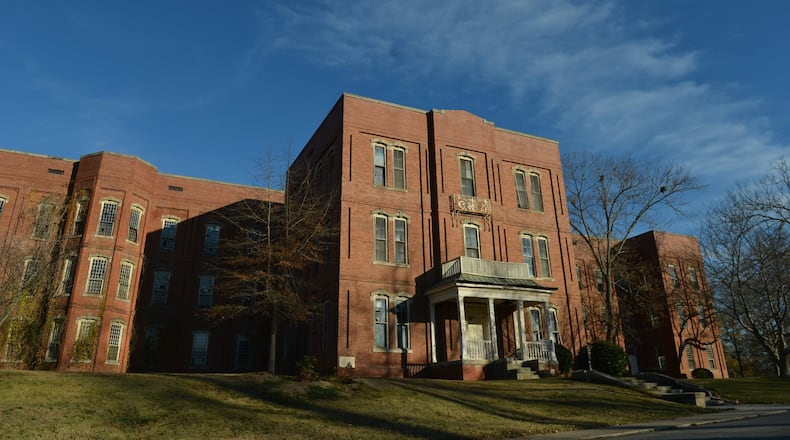In 1842, what was then called the Georgia Lunatic Asylum opened for business in Milledgeville, the state’s capital at the time. The sprawling facility would become the largest mental institution in the world, topping out around 13,000 resident patients in the 1960s. Today, what became known as Central State Hospital operates in a reduced capacity primarily as a facility for the psychiatric treatment of people in the state’s criminal justice and corrections systems.
But the institution still looms large in the imaginations of many, especially those who grew up in Georgia under the threat of getting “sent to Milledgeville” if they misbehaved as children.
Author Mab Segrest became interested in Central State Hospital when she set out to write a book about Georgia author Carson McCullers. Something about housekeeper Berenice’s threats to send young Frankie “to Milledgeville” in McCullers’ novel “The Member of the Wedding” captured Segrest’s attention and prompted a memory.
“My Aunt May in Tuskegee, Alabama, told me a deep, dark secret when I was in my 30s that my great-grandfather on her side of the family had died at Bryce Hospital in Alabama in 1901,” said Segrest, referring to that state’s mental health institution. “Apparently, he had been committed by his family when he had been seeing people shooting at him from trees, and then he started to shoot back. His family … thought he was dangerous and committed him. He died six months later from a skin infection.”
Professor emeritus of gender and women’s studies at Connecticut College and author of “Memoir of a Race Traitor,” Segrest began researching the history of the hospital and grew fascinated.
“What richer story than Southern insanity?” she said. “I was completely hooked as a Southern storyteller. Two weeks later, I was on the grounds.”
The result of that fascination is her new book, "Administrations of Lunacy," an examination of the hospital's history and the origins of American psychiatric practices told through the prism of race. It was a natural approach, given the research, she said.
“The more I dealt with the material and absorbed it, the more I saw that the through line is race,” said Segrest, speaking from her home in Durham, North Carolina. “Why is that surprising? It’s founded in 1842, antebellum era. … There were 17 major plantations in Baldwin County before the war, and two-thirds of the legislators who came to the Capitol in Milledgeville were slave owners. And from that Capitol, the Legislature and the governor oversaw both Indian removal and the bringing of slaves. To start there, and to tell the asylum story from there, felt like a new perspective on psychiatry.”
Segrest spent more than a decade poring over hospital records, oral histories, patient narratives and newspaper reports, including many from The Atlanta Journal-Constitution. The insight her book brings to psychiatry’s earliest practices is intriguing, and the portrait it paints of the human toll draconian cost-saving measures took on patients’ lives is chilling.
Along the way, the book details the evolution of medical and psychiatric practices. When the institution opened, it was ruled by humoral therapies such as blood-letting and induced vomiting. Later came moral therapy, a precursor to contemporary psychiatric practices that incorporated spending time in nature, structured activities and talk therapy. Eventually, occupational therapy became the predominant form of treatment, to such an extent that patients were operating a highly profitable farm by the late 1800s. One annual report lists production of 27,014 gallons of sweet milk, 1,810 bushels of sweet potatoes and 27,728 pounds of pork slaughtered. And yet, by the early 1900s, patients were falling ill and dying in alarming numbers due to pellagra, a disease caused by poor nutrition.
In 1867, the institution accepted its first black patients, who were housed in what was called “the colored building.”
“It gave me the chills as I went through all these ledgers, roll after roll of microfiche, to see the first black patients,” said Segrest. “There was something about them having been through slavery and the Civil War … and then to end up in the Georgia asylum. It seemed like such an exhausting and perhaps gruesome trajectory.”
A report from 1893 details the inequitable distribution of resources to patients that year. At the time, there were 1,146 white patients and 530 black patients. Beyond basic clothing, white female patients got palmetto fans, writing pens, envelopes, spectacles and toothbrushes. Black female patients only got irons.
Early on, psychiatry ignored the impact of external forces on mental illness. Behavioral aberrations were attributed to poor heredity. It was common to blame mental illness among blacks on emancipation from slavery.
“By as late as 1895, psychiatry was putting this forth, which was an old anti-abolition idea from the 1840s that freedom would make black people crazy,” said Segrest. “Everything was (attributed to) heredity. In the Civil War, if you cracked up in these brutal battles, it was because you had bad heredity and you lacked courage, not because you were under an astounding amount of violence and stress.”
With the introduction of Thorazine in the early 1950s, drug therapy took hold at Central State Hospital, and the psychiatric community as a whole. So began the march toward deinstitutionalization of mental patients. In 1959, The Atlanta Journal-Constitution ran a series of Pulitzer Prize-winning articles about “scandalous practices” at the Milledgeville institution, including doctors receiving payment for allowing pharmaceutical companies to test new drugs on patients without their knowledge.
Despite such dire circumstances, the book manages to end on a somewhat upbeat note.
“A lot of times where you have the worst things, you have the best things, too, because people step up to try and do something about it,” said Segrest. “Rosalynn and Jimmy Carter are an example of that. They first went to Milledgeville when Jimmy’s cousin was sent there, and they saw what they considered this medieval institution.”
As Segrest explains in “Administrations of Lunacy,” Rosalynn was put in charge of mental health when Carter became governor of Georgia, and during that time, she instituted reforms. The Carters hoped to repeat that success on a national level when he became president, but the strides they made were undone when Ronald Reagan took office and cut funding. The Carter Center in Atlanta has since picked up the torch.
“I consider Mrs. Carter one of the heroes of the story,” said Segrest. “At the Carter Center, she has a health program there to try to get (reforms) in place. The Carter Center has been one of the shining lights. I think that’s one example of the best in Georgia happens because the worst has happened here.”
NONFICTION
By Mab Segrest
The New Press
416 pages, $28.99
About the Author
Keep Reading
The Latest
Featured





